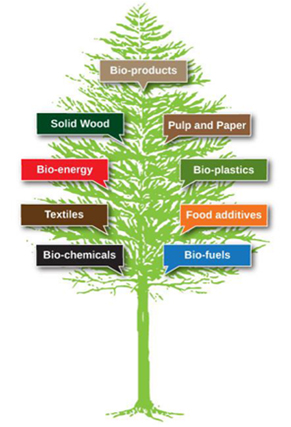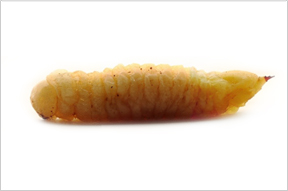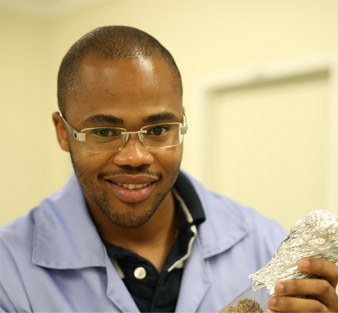Our economies and our ecosystems rely heavily on trees; that means the health of our planet depends on the health of our forests.
Yet now, more than ever before, many trees are sick and dying because of pests and the diseases they cause.
And plantation forests – trees planted to meet an ever growing human demand for wood and wood products – are even more at risk than natural forests. The Sirex woodwasp (Sirex noctilo), which targets pine trees specifically, poses one of the biggest threats to many of the world’s pine forests.
Methods to control this pest exist, but a solution that works in South Africa does not necessarily work in Brazil, and vice versa. Successful eradication often depends on local conditions, such as the variation of wasp or tree species found in a specific area.
What would happen if we don’t find better ways to control pests like Sirex? What if global Sirex infestations become unmanageable? Imagine a world without pine trees and other forests. Imagine the cost of having to import forest products. Imagine the impossibility of reviving a collapsed forest industry.
Imagine what would happen to the 1/6th of the world – that’s over a billion people – who rely directly on forests for their livelihoods.
Government doesn’t want that to happen. The forest industry doesn’t want that to happen.
Scientists can help make sure it doesn’t happen, by helping government and industry approach the problem scientifically.
Researchers at The Forestry and Agricultural Biotechnology Institute (FABI) at the University of Pretoria study tree health from every possible angle to support forest pest management locally and internationally.
When it comes to the Sirex woodwasp, FABI wants to understand every aspect of the pest so that they can fine-tune control strategies.
They've known for some time that microscopic worms called nematodes can be used against Sirex in an approach known as biocontrol: the nematodes infect wasp larvae, the females of which ultimately become sterile. A fungus that lives in symbiosis with the wasp plays a key role in this biocontrol approach, since the nematodes must feed and breed on this fungus in one phase of their lives in order to infect the wasp larvae in another.
But how effective a nematode is at controlling wasp population depends very much on the characteristics of the nematodes, fungi, wasps and even the pine trees into which the wasp injects its eggs. To select the best nematode option for a specific region, all the links in this complex food chain must be understood.
One big leap forward is the sequencing of each organism’s genome by FABI researchers. With the blueprint of
what makes each character in this story the way they are, scientists can hone in on the characteristics that
matter for effective biocontrol.
An understanding of genetics also allows FABI to develop tools to select the best nematode for the job, to create global maps of the natural distribution of different variants of nematodes, wasps and trees, and to investigate new potential methods of biocontrol, such as creating sterile male wasps to introduce into the wild.
FABI shares new findings
with government and industry to keep our trees healthy through the Tree Protection Cooperative Programme (TPCP) and a national Sirex Control Programme. It is a
model partnership between different sectors, namely business, policy-makers and scientists. FABI, as a global
front-runner in holistic tree health research, has in fact called on world leaders
to adopt a similar model, and to tackle the problem on a global scale through international collaborations and
multi-disciplinary research.
Humans have relied on trees for firewood, shelter and furniture for thousands of years, and we’re still finding new uses for every part of a tree.
Solid wood is used to construct buildings and the furniture within them, and wood pulp provides paper for printing. Woody fibres are used in materials like textiles and eco-friendly packaging plastics.
Left over woody mass and leaves are a source of cellulose, which can be fermented to produce bioethanol, a biofuel that is more environmentally friendly than fossil fuels.
Cellulose is also used to make ice cream creamier, and is used in many other food additives.
Forests also provide all sorts of other ecosystem services that support farming, and are a vital link in many
natural food chains.
The female Sirex woodwasp lays its eggs within a hole it bores into pine trees. The fungus that lives in symbiosis with Sirex, Amylostereum areolatum, resides in a sac at the base of the needle the wasp uses to drill into the wood. When she deposits her eggs within the tree, she also deposits some of the fungus, and a toxin that weakens the tree, allowing the fungus to take hold and start feeding on the wood. In this way, the tree’s cellulose is broken down into sugars, which become food for the wasp larvae. The fungus will continue to spread, feed on the tree and eventually kill it. The new adult wasps that grow from the larvae will take some of the fungi to another tree to repeat the cycle.




Ludwig Eksteen, a PhD student at FABI, studies the characteristics of pine trees to find out what makes some more susceptible to the wasp toxin than others. Ludwig is also a talented photographer, and has taken many close-ups of S. noctilo.
FABI researchers have recently summarised much of the information scientists have about managing
Sirex. This diagram (right) is taken from that summary:
Nearly 20% of the world’s populations depend on forests.
In South Africa, 170 000 people are employed in forestry industries, which exports $1.7 billion worth of wood products every year.
Those exports largely depend on South Africa’s 1.3 million hectares of plantation forests, half of which (51%) are pine. Pine trees in plantations are much morevulnerable to pests like Sirex than pine trees in natural forests.

Globally, over the past 25 years, 129 million hectares (an area about the size of South Africa) of natural forests have been lost due to man’s needs for wood, clearing for agriculture and other man-made threats. The remaining natural forests are vulnerable to invasive pests and to pests in general because of stress factors like pollution and ecosystem disturbances. The 110 million hectares of planted forests that have replaced lost natural forests are, as mentioned, even more vulnerable to pests.
Source:
Food and Agriculture Organization of the United
Nations | International Union of Forest Research Organizations | Forestry South
Africa
Pine is not indigenous to South Africa, so pine plantations have to be carefully looked after to ensure they are not stressed by threats they have not evolved to deal with. Such threats weaken the trees defences, making them even more vulnerable to attack by their own natural enemies like the Sirex woodwasp.
In addition, because Sirex is not naturally found in South Africa, the wasp has no natural enemies here. Invasive pests like Sirex can thus easily flourish if not managed properly, and have done so in recent years, causing billions of rands of damage in southern hemisphere plantations including in billions of Rands of Brazil, Argentina, Chile, Australia and South Africa.
Finally, plantations are often made up of a single species of tree, all of the same age, meaning that a pest
or disease can rapidly devastate an entire plantation if the species is vulnerable to that threat.
The Deladenus siricidicola nematode is a tiny worm-like creature that feeds and breeds on the wasps’ fungal passenger during one stage of its lifecycle. This does not contribute to biocontrol, but rather allows the nematode to reach another stage of its lifecycle where it is able to infect the larvae of the wasp. When the larvae eventually develops into adult wasps, the nematode infects the eggs of female wasps, rendering them sterile. These sterile females don’t themselves die, but all the eggs that they will lay as adults will not develop into new larvae. Instead, the eggs are filled with nematodes, so the wasp pests themselves start spreading the biocontrol agent to other trees.
In this way, the wasps produce less offspring every generation, and so the population gets smaller and smaller over time.
Nematodes are introduced into affected trees in a process known as inoculation when wasp pest outbreaks are detected.
On the right is a diagram taken from FABI researchers’ recent review of Sirex management:
After inoculation, the nematodes spread naturally through Sirex populations, parasitising between 5 and 99% of a given Sirex population. In South Africa in 2014, D. siricidicola infected an average of 50% of Sirex woodwasps sampled from various populations.
Through this process (or one very similar), Australia, South Africa and other countries have managed to limit Sirex infestations to an average of 3% in most plantations. This changes constantly, however, as Sirex spreads to new areas or new strains evolve to avoid current biocontrol strategies.
In Brazil, researchers estimate that an Integrated Pest Management plan for controlling Sirex using nematodes would save US $6.6. million yearly in lost income.
There are many genetic and environmental factors that determine the success or
failure of Sirex wasp populations to grow. These factors include the age and location of its pine
tree host, the presence of other competitor organisms or natural enemies, its own genetics and the genetics of
its fungal passenger. The nematode biocontrol agent has to be precisely tuned into all of these variables in
order to beat its opponent. It’s a war where both sides have incredibly complex strategies; if the nematodes
are to win, they have to exploit specific weaknesses of the Sirex wasp and its fungus.
If scientists don’t understand the survival strategies of Sirex, its fungal symbiont, its pine tree host, and its natural nematode enemy, they won’t be able to optimise biocontrol strategies.
The FABI lab generates over 1 billion nematodes each year to assist with biocontrol in South Africa, and they’ve been doing so for more than a decade. This is enough to inoculate 10 000 trees annually. In 2014, 8836 trees were inoculated in South Africa. Thanks to these efforts, FABI has saved the South African Sirex Control Programme tens of millions of rands in nematode production costs, and hundreds of millions of rands in avoided loss of trees and tree products.
To ensure that these nematodes are suited to their task in different locations and under different circumstances, a team of researchers are constantly looking at new ways to improve management strategies, from many different angles. They also actively share new knowledge with the world.
The research team is led by Prof Bernard
Slippers, Dr Brett Hurley, Dr Jeff Garnas and Prof Mike Wingfield. Here are
some of the angles they are looking at and questions they need to answer to ensure trees remain
healthy:

Finding the right worm for the job
Osmond
Mlonyeni, a PhD student at the University of Pretoria’s Forestry and Agricultural Biotechnology
Institute (FABI), studies the genetic code
of microscopic worms known as nematodes.
The species he is interested in, Deladenus siricidicola, is used to combat a devastating wasp pest in pine forests. As there are many different variants of this nematode, with some being more effective than others under different circumstances, his goal is to find signature patterns within their DNA that would indicate which nematode works best for which conditions.
At the University of Pretoria, the solutions to change the world can be found in the research we do today; creating a lasting impact on pine plantation forests throughout the world.
Make today matter
Copyright © University of Pretoria 2025. All rights reserved.
Get Social With Us
Download the UP Mobile App